#resin protection equipment
Text
Re-Organizing Things 📦 & Resin Mask
My new Sterilite storage containers finally arrived in the mail today. A little late but that's okay- it's been rain storming again where I live. We even have predicted snow? Cali expected to get snow? 🌨️❄️ Hah. Yeah right. I'll believe it when I see it.
(No, that's not me being negative, that's me being grounded. I've lived here my entire life.)
But anyways! I bought these two containers to stack upon each other for basically two levels of flat surfaces, vs. the one flimsy (but cute) fabric cube I had before. These also have a seal that according to the website:
💠 "Gasket Boxes offer a gasketed seal to safeguard items from both air and moisture, keeping those special belongings safe from the elements, dust and pests."
Most my storage containers in the garage are like this because of this seal. Last thing I want is for moisture to get in and penetrate things. I see what happens to my soda boxes out there in the winter lol, they become soggy and warped and just yuck.
If you want the Walmart link to these exact ones, it's here: https://www.walmart.com/ip/Sterilite-Plastic-Storage-Container-12-Qt-Gasket-Box-1942-Clear-W-Blue-2-Pack/855654663. You can also find more just searching Sterilite. But they can get pricey- you're buying that fancy 'seal' after all.
Let me show some pictures.
Another reason I like these so much, and I believe I mentioned this, is because the bottom of them is flat. I don't mean a rounded-flat, I mean square-flat.
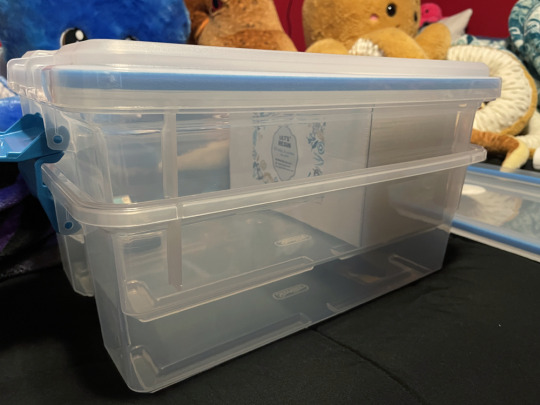
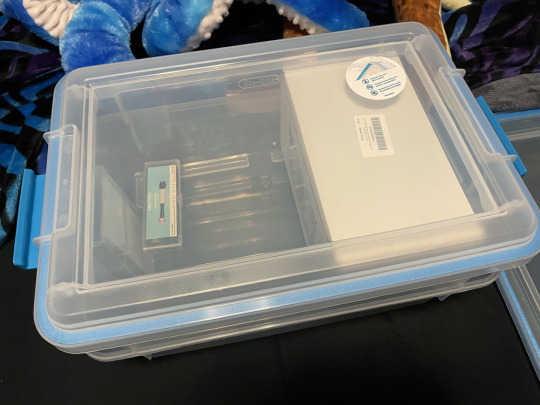
With most other containers, the edges will curve up so much you cant push items or boxes all the way to the edge and you lose so much room in the box. It's actually a huge let down- but not with these. You can clearly see I pushed a box all the way to the side and I'm losing none of my inner space. I love these containers.
Think I have more pictures of these in past blog posts where I'm storing bubble mailers and such in them.
Time to put them to the test with fitting my resin molds in them. I only have room for two in my shelving otherwise I'd totally buy more.

On the left is the "flimsy fabric cube" I was referring to above, lol.
But yes, these do fit all the things! And everything is flat for the most part. I'll have to do some digging to pull stuff out when I need it- which may become a bit obnoxious time to time... I wish I had room for more of these 🤔💭 even just one or two more. Especially with the way I keep buying molds 😅
I'll figure out something, and I might end up buying more of these.
(It's important to keep resin molds flat because you want your resin to cure flat. If your molds have curls or deformities, they're going to cure that way too. Ofc there are some exceptions- like some silicones are heavy/loose and bounce back, some molds are small, etc.)

I'm not trying to turn this into a total insert-product post or anything but it's kinda looking that way isn't it? 🙃🫠😅
Up until now I've only worked with UV Resin, but I'm going to change that this year and work with epoxy, and with that means I need to have proper protection equipment. If you're reading my stuff, I hope you're taking note of this and considering this yourself.
At first I just went to Amazon and searched for "resin mask" and "resin mask for women" or something simple and got a plethora of options, it was a bit overwhelming.
After reading through several items and many reviews, I almost settled upon one. Almost.
I then saw this comment.

And decided to look up some things. (Time to use some braincells~)
So, the mask I was looking at (that, that comment came from) was the mask + the filters + goggles. The price of it came to:

That one can be found here btw: https://a.co/d/hfoAiO5, and it looks like this:
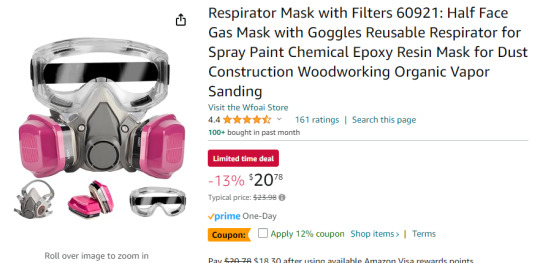
BUT! Let's take a look at 3M like she's suggesting.
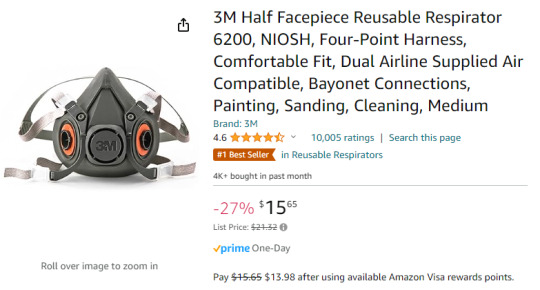
(Link: https://a.co/d/1XrdvGU)
Kay...
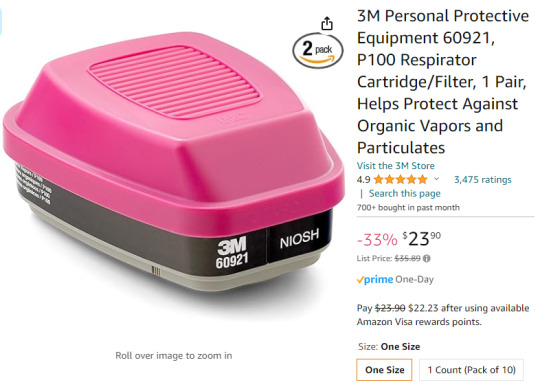
(Link: https://a.co/d/atr8H4I)
Okay...
Now we're just missing goggles. But there's many pairs of goggles out there, this is just the baseline for the mask + filter.
21$ for a cheapy wanna-be knockoff (and people are wishy-washy on its validity to keep you safe) vs. 40$ for the real deal.
Putting two and two together I was kind of like wait... this isn't adding up for me. The 20$ one kinda feels like a scammaz, y'know? Or maybe you can see it as a really good deal 🤷🏻♀️
If you're still not sure which is the best option at this point, let's find a pair of goggles.
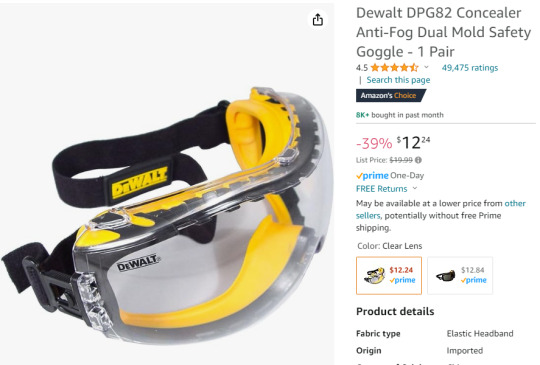
(Link: https://a.co/d/frylBF6)
My Bro uses this brand all the time at his construction job and look at the amount of reviews on this. In addition, the comments and vid reviews are great on them too.
Also in the reviews on these goggles, are a bunch of photos of people wearing these with the 3M mask and other types of masks. So they definitely work with masks- that is something I was looking for specifically.
Another thing I was being mindful of, is if they cut off your peripheral view cause that's a thing that drives me nuts. According to one of the video reviews- they do not, because of how they sit on your face/head 👍🏻
That puts us around the 52$ mark if I'm just averaging the price, not really doing actual math.
Yeah you could go the cheaper route and get a "knock-off" for 20$, but is it worth the risk? That's something you gotta assess for yourself, I guess. Personally I bought all of the separate things, I'd rather be safe than sorry. I did however link all these things here to provide information and options.
If you're going off the grid of information I've provided, just make sure to read reviews and watch video reviews. Make sure you can return the product. People are usually vocal if they have complaints about a product, but sometimes you have to judge that for yourself as well cause flukes do happen.
Or, in some cases people don't know how to install/operate things, they'll have user-errors and blame the company or product for their faults. Even if an item arrives damaged, they'll blame the company for the item's condition when it was more likely the fault of the Shipping Courier. In that case, is their customer support good? Is that mentioned in their reviews anywhere? Be mindful. Do research.
There might be better brands or options that I don't know of. I'll be the first to admit I don't know everything 🤷🏻♀️. I didn't even bother to consult my Bro on this (cause I'm not the type to just randomly dial up/text someone and be like heyyyy~ question~)
Can always consult Google and Youtube too with keywords like "Best Resin Mask" or "Best Resin Goggles". I didn't consider to do that this time around; Those are usually hit or miss for me. Most times they take you to websites of "Top 10 ___" and then they're super expensive out of budget items and 🫠 meh.

Edit: The mask stuff just got here!

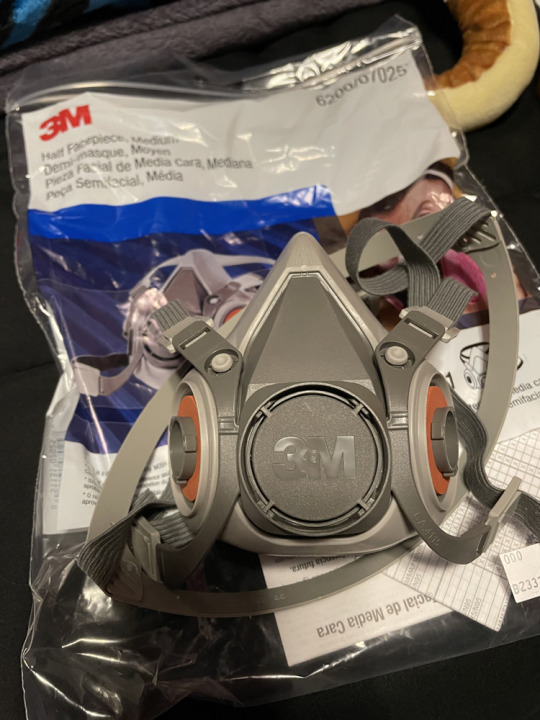

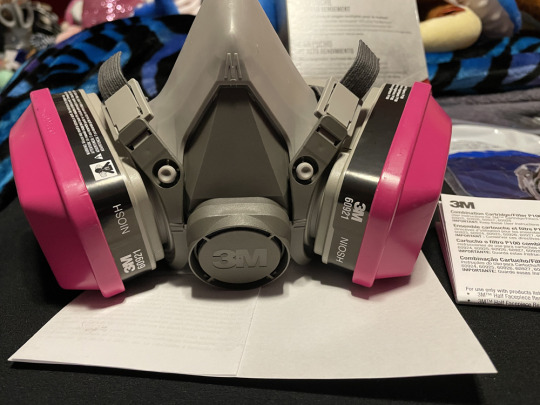
The filter was very easy to install onto the mask and I don't smell anything weird coming from it.
It does fit me and it's adjustable- if anything it tricks me into feeling like it doesn't because I'm used to using a headset at the PC that sits more forward on the top of my head, and this sits far back on my head. That's going to take some getting used to. But it is secure, it's not going to fall off. It's like a loose helmet- It's a mask.
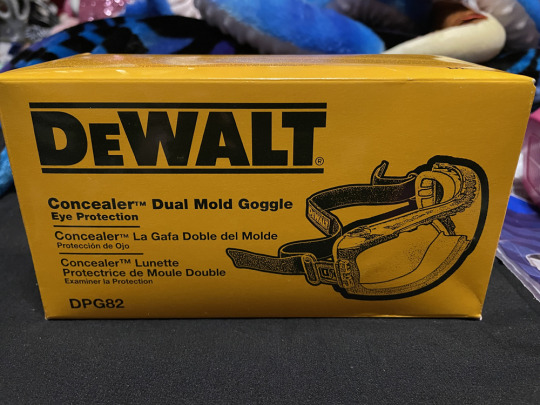
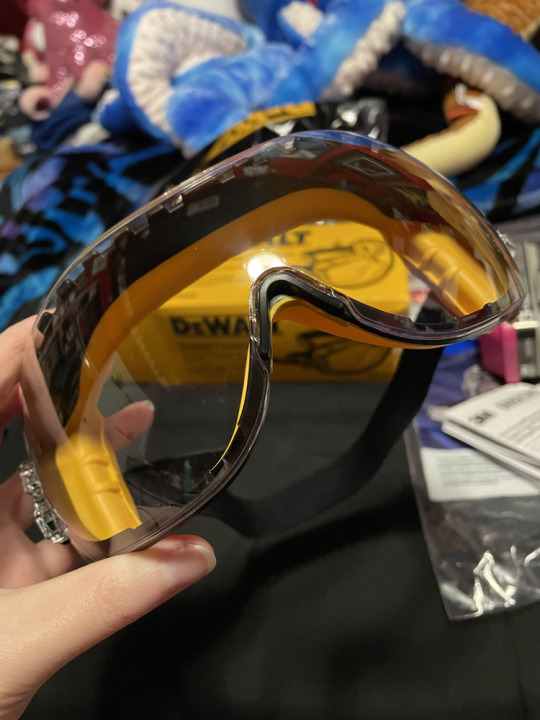
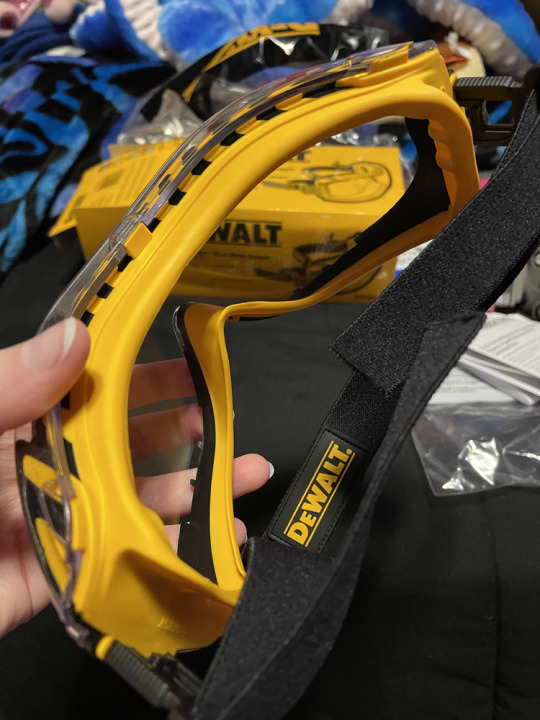
Exactly how Amazon reviews described this. When trying these on, I could see out my peripherals- which I love.
These sit up high on the cheeks and the nose, so they leave room for that 3M mask (or other masks). They're very clear, almost like you're not wearing anything at all. I'm surprised myself at how much I love these 💟 (stamp of approval)
0 notes
Note
reporting in to send the ask for what each of the shepherds carry in their packs 🫡 blade gets tapped for a what’s in my purse vlog and the video is just a knife. and a knife. and a knife. and a knife—
Thank you for your service 🫡
Out in the field, if you were to grab a pack and rummage through it, only to find it wasn't yours, you'd find the following (excludes the standard field kit for Shepherd officers, which includes a bedroll, a tent/tarp, blanket, canteen, soap, toiletries, various changes of clothes, equipment to care for horses/ahfuri, mess kit with eating utensils and tin plates and etc., and the obvious standards like money and etc.):
Blade: a sturdy, rigorously-organized, plain and utilitarian pack containing: fire-starting tools (flint, steel, and tinder). utility/hunting knife (for things like cutting rope, skinning deer and fish, etc). dagger (for emergencies. in case the ones he keeps on his person are taken away from him). small portable writing set (comes with a flat, collapsible tablet that serves as a writing desk, ink, parchment, and pen) for composing letters/orders/messages to send home. emergency first aid (minimalist: basically consists of a bottle of alcohol for sterilization, needle and medical thread for stitches, and some clean bandages). dried meat or jerky, hardtack biscuits (emergency rations). small cooking pot. whetstone (for sharpening his weapons). fishing hook and twine. hawking whistle. maps. rope. various small utility tools.
Trouble: a battered, worn and stained rucksack containing: fire-starting tools. charch and matches. various snacks and extra rations (trail mix, etc.). cubes of fat and bullion or various seasonings for meals. small cooking pot. extra ammunition (a lot of it). tools to maintain and clean his firearms. utility/hunting knife. rain-proof cover (can be used for himself or his rifle). extra gloves and socks. whatever novel he's currently reading. explosives (😳), various tools to create distractions (smoke grenades, etc.). signaling mirror. compass. timepiece. dice. playing cards. insect repellent salve. maybe fishing hook and twine if he expects to be "roughing" it for a long time! spyglass.
Tallys: a clean, well-maintained leather bag with Elvish adornments containing: large kit containing several different vials of various elixirs, tinctures, oils, and extracts (serve different purposes like reviving the unconscious, numbing pain, putting someone to sleep, etc.) as well as various different powders and dried herbs (some are poisonous, as Chase had the misfortune of discovering when he snooped too much); teabags; map; Elvish animal whistle (used for various purposes: as an animal or bird lure, for communicating while hunting or in camouflage, as a distraction); tifin (small Elvish flute) if she thinks she's going to be away for a really long time; Elvish hunting knife; kit of wax, resin, twine, and whittling knife to maintain her bow and arrows; first aid kit; woven Elvish mat (often used for meditation and dawn prayer rites, but can be used just for sitting more comfortably on things, as a lap blanket, or even as a scarf/shawl for extra warmth); small empty containers for foraging and protecting things like berries, mushrooms, leaves, etc.; Elvish field guide describing the various uses of flora and local plant matter; Elvish calendar and daily book of proverbs to keep track of the days (also doubles as a brief journal); pen; fire-starting kit.
Shery: Shery doesn't actually embark on missions into the field and actually has never left Haven (unless you're reading her latest short story on Patreon, lol), so the contents of her pack are at the moment hypothetical! Because of her inexperience, I'd guess that she'd both err on extreme overcaution and overpacking and also make some impractical choices, like bringing too many books, outfits for all kinds of weather, a parasol, a sewing kit, a little stuffed animal for good luck, a teapot, a nail file, an extra blanket and a fluffy pillow, and things like that! But she'd also have sensible choices, too, just way too many of them!
Riel: when he goes on business trips he typically has a whole trunk of things with him LOL but if forced to come along on a field mission, my guess would be that he'd mostly bring different changes of clothes, his hygiene and toiletries kit (complete with hair pomade, cologne, and fresh handkerchiefs), and then would just assume/rely on gold getting him whatever else he needed 😂😂 Actually he'd also certainly pack a valise with whatever current documents or contracts he's been working on, plenty of stationary and ink, a notepad for taking notes, a foldable writing desk, books, and whatever proof he'd need of being (at that time) Master of Merchants Guild, like his official stamps and wax seals and whatnot. Basically whatever he'd need for doing work on the road! 😂 Oh, he'd also pack a gun. Just in case!
Chase: a deceptively-slim, innocuous rucksack that is surprisingly hard to open if you're not familiar with it, containing: several lockpick sets. a bottle of alcohol to bribe informants with (or light a fire, sanitize a wound, what have you). rope. file. utility knife. whetstone. extra ammunition. fire-starting kit. tools to maintain his firearms. charch. playing cards. whatever book he's currently struggling through as homework. various shiny trinkets that can be traded, bargained, bribed, or used as a distraction. devices used as distractions (flashbags, smoke grenades, low-level explosives). grooming kit with comb, pomade, cologne, mirror, etc. scarf (can be used as a fashion accessory, mask to obscure lower half of face, or, in a pinch, as a method of strangling someone 🙂). wire (don't ask). mysterious vials (could be poison, could be acid to burn through locks). different accessories, clothes, and wig for different disguises. special gripped shoes for climbing and capering. small grappling hook. net/bolas (typically used to trip opponents up or rig traps). recently-acquired reed harp (harmonica) that he uses to amuse/torture teammates with.
Red: a slim, casually-packed, strangely collegiate bag (he generally travels light because he cheats and conjures most of what he needs as he needs it), containing: whatever book he's currently reading. field journal and writing implements. foldable writing desk. scroll container to protect any precious documents or papers he might come across. various Mage-y implements like chalk, lyme, certain compounds that help with arcane magic and drawing runes. measuring ruler. various charged lodestones and keystones. maps. compass. grooming kit for his endless hair needs 😳 (pomade, comb, mirror, etc.). multi-use mini game board (you can play various games on it like Elements, checkers, sui, etc.). small containers for collecting specimens. travel lantern (for exploring ruins without having to deal with a guttering torch flame). insect repellant salve. salve for burns and aches. magnifying glass. small flat cushion for sitting/laying on if the ground is extremely lumpy.
Ayla: a carelessly battered, fraying rucksack with small carved totems dangling from it, containing: backup canteens of water (emergency only). collapsible trowel to dig holes (generally to dig up roots, tubers, or to find water). maps. compass. sundial. lots and lots of rations (the majority of her pack will contain non-perishable food). sewing kit (doubles both as first aid and for emergency repairs to clothes). colored twine (primarily used to mark trails so you don't get lost, demarcate certain things you'll need to find again later, and also doubles as a Jalis hand-game to play with another person when bored). playing cards. dice. rope. hunting/utility knife. lockpick set. sun lotion (to protect the skin). extra tarp (to erect emergency lean-to/rain shelter/shade; doubles as emergency extra blanket). file. hairties for her braid. jade stone from her parents. slingshot/leather thong to hurl rocks with (this is a deadly weapon in her hands). signaling mirror. survival whistle. small torch. fire-starting kit. whittling knife for when she's bored and wants to carve things into her staff or just out of hunks of wood. field guide telling her what's safe to eat and what's not. jalis rattle (sort of like maracas: it's a small wooden cylinder filled with dry rice) in case she's in the mood to provide a rhythm to someone else's music.
Briony: a fat, cheerful pack with many charms and souvenirs dangling from every strap, containing: a field journal/sketchbook full of sketches, drawing/writing implements. a hairbrush. haphazard grooming case (eyelash curler, a bit of blush, no mirror). fingerless gloves. her latest book. extra hair ties/hair ribbons. oils and rags to maintain her armor. whetstone. fire-starter kit. maps and compass. some snacks, but typically she forgets about them. fishing hook and twine. headscarf to conceal her hair if need be. field encyclopedia/traveler's guide (more about various landmarks and places of interest she might see than survivalist tips). first-aid kit (used more than most to deal with small scrapes and wounds). hunting/utility knife. spare dagger. stargazing map. spyglass. pouch full of pretty rocks or dried flowers she picks up along the way. spellbook full of spells she's learning/practicing along the way.
Lavinet: an expensive but practical and well-made leather saddlebag containing: compact maquillage and grooming case (hairbrush, lipstick, mirror, perfume, hair conditioner, etc.). extra riding gloves. extra handkerchiefs. whetstone, tools to maintain her lance and sword. tools to maintain her saddlery. horse treats. fur throw that doubles as small extra blanket, extra warmth as a shawl, or as a cushion to sit on. extra pair of riding boots in case one set fails. Naveen signet ring and official accoutrements. writing set, desk, and seal. current book. hat to shade her head from the sun. sewing kit and patches of fabric to repair clothes. first aid manual. wax (has various uses, but she primarily uses it to plug her ears if she absolutely needs to). fire-starting kit. chainmail that can be concealed under the clothes. stiletto knife. corset (you never know, darling!)
Halek: an ordinary, standard pack containing: tools for weapons maintenance (for his spear). small compact bow and quiver. hunting/utility knife. exorcist dagger. recipe book and culinary guide regarding exotic ingredients or places of interest. various ingredients he picks up in towns or foraging in the wild. cooking oil, seasonings and spices, emergency salt, cubes of fat and bullion and stock, dried herbs, dried meat and cheese, flour. water-proof, heavy cloak for winter travel (also doubles as an extra blanket, as the standard-issue one might be too short for him). collar to suppress his blood-rage if need be. fire-starting kit. elk treats. small bell to tie to his elk in case he needs to. twine. grappling hook and rope. maps and compass. herbal teas. fishing hook. animal bait and snares. bear repellant. cooking pot and small frying pan. sand (used to scrub pots and pans when water is scarce or frozen). signal whistle. special snow boots if traveling through snow.
90 notes
·
View notes
Text
For anyone curious about resin printing prices, I just thought I'd share my 2 cents as a hobbiest printer.
Resin printing requires a lot of PPE (more than filament printing afaik, though that requires some too)! Protective equipment alone can run upwards of $100 dollars. I spent time hunting for good prices and my setup ended up being around $130. You need stuff like nitrile gloves to handle the resin with, masks (ideally a good particulate and VOC filter so you can sand with the same mask you use for fumes), ducting to vent the fumes out somewhere (and everything else venting involves), and so on. There's lots of little things, and they'll add up fast.
There's also other equipment you'll need besides just a printer. Resin printing requires post processing requires something to wash the print in (usually IPA) and something to cure it with (UV light). You can re-use IPA and cure in the sun, but how you choose to process the resin afterwards is still an up-front cost to consider. You'll need containers to store the IPA to save it in, and you'll need a funnel with a good filter in order to save extra resin from prints. (Up-front costs for long-term materials saving. if you skip those, you'll pay more replacing them in the long term.)
In order to have a setup that's comfortable instead of only functional, many people will want extra supplies for their battle stations, like mylar boxes (like indoor greenhouse tents) to contain fumes and hide the printer from sunlight, and silicone mats to protect surrounding surfaces from resin. And omg, you can see how this is starting to take up a lot of space...
That's not even touching the cost of resin itself! even really cheap resin is going to be over $10 a kg. and if you want more than one color, you're either going to need to buy lots of UV-proof chemical bottles to store your different custom mixed colors, or you'll need to buy more colors. (If you mix your own, you'll need dyes.) You'll need to acquire elastic to string the doll, and you'll usually want to purchase metal s-hooks. resin has many strengths as a medium (high detail, etc), but unfortunately, it is brittle, which makes it a poor candidate for tiny objects under a lot of stress. so, 3D printing the s-hook is usually not a good idea. (Unless you're paying extra for, like, some siraya tech tenacious, or something like that. but even then, I'm not sure it's the best choice.) And if you want to assemble the doll with magnets instead of snap fits, you'll need magnets too.
TL;DR Resin printing is a high-investment hobby. It might be cost effective if you're making ten dolls, but if you want one or two, it won't save you money or time. (I still think people should try making their own dolls if they're interested!! :) It doesn't have to be about money. Making your own custom dolls is a rewarding experience! But it's not a cheat code to avoid the cost of this hobby.)
~Anonymous
26 notes
·
View notes
Photo


I am thrilled to unveil the highly anticipated presale featuring two captivating recolours of the beloved Elder Scroll pin. Whether you missed out on the original design or simply desire a new colourway to grace your collection, this is your exclusive chance to secure these mesmerising pins before they vanish!
> when live they will be here < goes live 19th may 5pm bst (british standard time)
*golds are completely sold out and won’t be returning
Key Features:
✦ Limited Edition: Only 50 pieces available for each variant.
✦ Generous Size: 2.5 inches in length, making a bold statement on any pin board or accessory.
✦ Exceptional Quality: Sandblasted plating ensures a sleek and polished look, while the resin topping adds protection for the rainbow variant's exposed metal.
✦ Durability and Elegance: Crafted with hard enamel, these pins are built to last, providing long-lasting beauty.
✦ Subtle Sparkle: The black variant features tasteful glitter accents, adding a touch of magic to your collection.
✦ Collectible Appeal: Each pin is back stamped and individually numbered, making it a sought-after item for pin enthusiasts.
✦ Secure Attachment: Equipped with three sturdy pin posts, ensuring stability and preventing any accidental slips.
#the elder scrolls#elder scroll#elder scrolls#tes art#teso#the elder scrolls online#skyrim#morrowind#eso art#teso art#sugaredshop#pins#pin collector#pin collecting#enamel pin
62 notes
·
View notes
Text

'The esophagus of the ungulopes are reinforced with thick, rubbery connective tissue that help protect their throat and digestive tract from the sharp and abrasive silica edges and deposits of saberleaf--and renders the esophagus and stomach wall virtually inedible and unpalatable to the predators that prey on them. Elastic and of a leathery consistency, even the southhounds whose diet, in some groups, consists primarily of ungulopes very rightfully exclude it from their diets. That is not to say, however, that it is of no use to them, as, with their ingenuity, found various functions for the ropy organ once dried and dessicated in the suns' rays. To young pups, it makes for an entertaining chew toy and plaything to keep them occupied and strengthen their jaws and teeth. Adults, in the meantime, use them as safety ropes to grab onto when negotiating difficult terrain, as flags for marking important locations, and, when affixed with carefully-selected plant thorns glued in place by resin, even worn around their necks as a protective accessory that protects their vulnerable throats from the bites of enemies, be it wild animal or hostile rival southhounds. These defensive collars, however, take great and gentle care to equip and remove with their limited dexterity, and have to be put on and taken off by another individual: furthering the interdependence the southhounds have with their packmates.'
----------------
#speculative evolution#speculative biology#spec evo#speculative zoology#hamster's paradise#art one shot#the calliducyon saga
77 notes
·
View notes
Text
Dice Lingo Sheet
All right, lemme tell you some words and what they mean when used in the dicemaking-world !
Keep in mind that this is not a universal way of working/ doing things, it's just my experience. Everyone does dicemaking their own way, as they should as long as it works for them.
dice : polyhedral, ttrpg dice. Not just d6s used for Yatzee with your Gran (no shade, Yatzee with Gran is awesome, get her some handmade ones for her bday)
dicemaker : a person who handmakes dice; also see "dice goblin" and "dice gremlin".
dX (insert a number for X) : a die with X amount of faces. D6 = a six-sided die.
sharp-edged : most handmade dice are sharp-edged (and some d4 can stab your foes), as opposed to factory-made dice which have rounded corners and edges
spin-down : a die (usually d20) with numbers in ascending order around the die, usually used to track points (health, mana, whatever) in various games.
stabbies, stabby boi : sharp dice that you could commit crimes with
atlernate shapes : new "weird" shapes that differ from the traditionnal factory-made dice; think crystal shapes, clipped corners, elongated shapes, etc...
dice goblin : a dice enthusiast
masters : a 3D-printed model of a die/a set of dice. Most dicemakers sand and polish these up to a mirror finish to make molds with them.
forbidden cronch : dice
PPE: Personal Protection Equipment; resin is not good for your skin, for your lungs, or any other soft tissues of yours. Nitrile gloves, a respirator with proper cartridges and a well ventilated space are a must for resin work.
molds : silicone molds dicemaker usually make themselves using 3D printed resin masters, there are different styles of molds; most common a sprue molds and cap molds.
resin : what handmade dice are usually made of, it's epoxy resin.
jesmonite / faux stone : a particular type of resin, makes dice that look like actual rocks and stones
a pour, pouring : a resin-pouring session. We mix our resin, our pigments, flex our skills, pour it into our molds.
math rocks : dice
dice gremlin : a dice enthusiast
silicone : most molds used in dicemaking are made of silicone.
pressure pot : a hermetic sealed type of tank, usually converted by the maker from pressure paint tanks, it's where we put the dice right after pouring to get rid of bubbles in the resin.
compressor : used in tandem with the pressure pot, it allows us to pressurize the pot in order to shrink the bubbles still present in the resin to shrink to undetectable size. Some makers use bike pumps in lieu of compressors.
forbidden candy : dice
raw : dice that just came out of their mold. They're uninked, unsanded, unpolished, and might look like they partied too hard.
flashing : not what you're thinking of. It's a thin sheet of resin that forms where the mold connect to its lid, or near the sprue
finishing : the steps after the dice came out of the molds; each maker has their own variant of it.
sanding : first step of the finishing process, the dice are sanded with whatever grit the maker deems appropriate, to even out faces and remove marks and/or flashing
click clacks : dice
polishing : second step of the finishing process : it turns sanded face back to a beautiful shiny finish.
inking : last step of the finishing process: painting the numbers in
blessing the dice : when the animal of a dicemaker boops the dice in an insanely cute manner, the dice have been blessed
There, now you can actually understand what we're going on about !
Dicemakers, don't hesitate to add to that list, I probably forgot stuff. Others, don't hesitate to ask me if you have a vocab question I forgot about !
158 notes
·
View notes
Text
Tek's Respirator FAQ for faceups & modding Ball Jointed Dolls
Copied from DenofAngels original posted date: Sep 21, 2010 Last edited by a moderator: Oct 10, 2016

Are you qualified to talk about this?
Yes. I [Tekenduis] am a Certified Respiratory Protection Tester/Trainer with extensive training in respiratory protection. I work at a company where my staff are exposed on a daily basis to some of the most harmful chemicals in industry. They can and will be exposed to things like silica, isocyanates and cyanide gas. Their short and long-term health is in my hands and I take that very seriously. Deadly seriously, in fact.
What is respiratory protection?
Respiratory protection is a part of your Personal Protective Equipment (PPE) designed to filter or block harmful substances from reaching your respiratory system. The hobbyists primary form of respiratory protection is the respirator. There are a great number of types of respirators, some useful only for certain applications (see more on this below). The two most common respirators for hobbyists are the disposable respirator and the half-face respirator.
The half-face respirator is a mask that covers your nose and mouth, and has cartridges that clip on, screw on, or otherwise attach to ports on the mask.
The disposable respirator looks like a dust mask or surgeon's mask. It is, as the name implies, made to be disposed of after a short period of time.
Why do I need it?
Many of the items that we work with as doll customizers are toxic and many of them are cumulatively toxic. You may feel ill for a while and then get better, but the sorts of diseases that can be caused by sanding processes and spraying processes can come back to haunt you many years down the road. These products can cause Cancer and Pneumoconiosis. Cancer may be treatable if caught early enough. Pneumoconiosis, which is respiratory diseases like asbestosis, silicosis and coalworker's "black lung" disease, is NOT TREATABLE. Your doctors will work hard to make you comfortable while you die. That is the most they will be able to do for you. If you get Pneumoconiosis you will DIE.
☠️ Are you scared? You should be. This is life and death. Do not play Russian Roulette with your health. ☠️
What do I need?
That depends on the application that you are going to be using your respiratory protection for.
Sanding
For sanding applications (including sanding of resin, apoxie and other sculpting materials, and wood), you need a respirator that provides at least N95 level protection. It should say N95 somewhere on the mask itself. If it doesn't say, it is not good enough. There is a scale to protection levels and anything above N95 is also acceptable (of course).
The levels are:
N95
P95
N100
P100
What does this mean?
The prefix ahead of the number will tell you if the mask is Oil Proof or Not.
The number will tell you the percentage effectiveness of the filter against particles of less than 0.3 Microns. An N100 or P100 filter may also be known as a HEPA filter.
On the bright side, having a small supply of these types of respirators will mean that you are following CDC and WHO recommendations for infectious disease outbreaks, which may or may not include the Inevitable Zombie Apocalypse.
P100 filters are also effective in welding applications.
N95 and above filters are most commonly found in the disposable variety and may also be referred to as "dust masks" or "surgical masks". Remember, if it doesn't say N95 (or one of the other codes listed above) it is not good enough!**
Spray
This includes all types of spray applications, whether you are spraying sealant (like MSC or Testors) or airbrushing or spraying paints.
The process of spraying releases aerosols (and this is true whether or not you are using an aerosol spray can product. Airbrushing paint creates aerosols too!) for which an N95 filter is not effective.
At this point, you will need to move into a mask that protects you against Organic Vapors AND has an N95 filter. This will mean moving into a half-face respirator.
Your respirator is no longer disposable and can be used again and again without ill effect; the only thing that will need replacing is your filter and (if applicable) your prefilter. Some respirator brands have an N95 filter built right into the Organic Vapour cartridge, but I recommend looking for one that does not, for ease of replacement. Cartridges and filters have different life spans and it is more economical to replace only the part that requires replacing (more on this below!).
Okay! I've got my mask, I'm totally safe now right?
No. There are three things that can negatively impact the safety of your mask; poor fit, improper maintenance and environmental levels.
Poor Fit
A respirator (of any type) is completely and utterly useless if it is the wrong size for you and is not fitted properly. Please ensure you've read the section on fitting your mask to ensure that your mask is correctly fit.
How do I know if it fits?
According to my local Occupational Health and Safety Code, a respirator cannot legally be used in a workplace environment if it has not been correctly Fit Tested. Keep in mind that half-face respirators come in various sizes. Most women and men wear a medium but if you have a particularly slender or wide face, you may need a small or large. If you have a crooked nose, or sinus problems, look for a mask made of silicon; you will find it more comfortable than plastic or rubber.
Improper Maintenance
Your respirator is equally useless if you are not properly maintaining and caring for it. This includes care of the mask between uses and replacement. Please see the section on maintaining your mask for more information.
Environmental Levels
Environmental levels are important to take into account, as your mask can only protect you against the things it was designed to protect you against up to a certain concentration. since I'm sure none of us have the money or inclination to commit to environmental testing of our workspaces, the best way to ensure this is to make sure that the area in which you are working is properly ventilated before you start your project, and until well after you are finished.
Open your windows, PREFERABLY PLEASE work outside so that there is fresh air circulating in the area you're working in.
If the air is particularly still (no breeze) while you're working, it is worth investing in a simple fan. Set it up in your window, with the fan blowing out the window (ie: the front of the fan where the air blows from facing towards the window). This will help pull the toxins out of your room. Alternately, if you are working outdoors, set the fan up on your table to help promote air movement.
Fit Testing
Fit testing uses a noxious but harmless substance (usually either irritant smoke or Bitrex; an additive used to create bitterness in household cleaners to prevent children from tasting them) to ensure that the seal between the mask and the face is tight and proper. Qualitative fit testing is the most common type, and requires the user of the mask to confirm the presence of the noxious substance. In some cases (depending on chemicals in the environment or failure of the Qualitative test) Quantitative fit testing may be required; this type of fit testing uses scientific sensors to record levels inside the mask. If you have access to fit testing, especially with a half-face respirator, I encourage you to take advantage of it! Fit testing needs to be redone every two years, in the case of weight loss or gain of more than 15 lbs or in the case of surgery (including dental) involving the face.
And if I don't have access?
I have done hundreds of fit tests for staff at my place of employment and I can usually tell how well a mask is likely to fit prior to the fit test being done. This is done with a simple self test. In order to be effective this test must be done every single time you use the respirator (even if you pull it down to talk to someone and put it right back on!).
For Disposable
Step 1: Put your respirator on.
Step 2: Cup your hands tightly over your mouth and nose, over top of the respirator.
Step 3: Suck in a long breath. You will get air, but it should all be coming in through the small cracks between your fingers. You should not feel any air coming in from around the nose piece or under your chin. If you do, refit the mask and try again. If you cannot complete this successfully, you will need either a larger or smaller mask.
Step 4: With your hands still over your mouth and nose, blow out. Again, you should feel the air moving past your fingers, and never around the bridge of your nose or under your chin.
For Half-Face
Step 1: Put on your mask and make sure the straps are tight.
Step 2: Cover the cartridge, as much as possible, with the palm of your hands and suck in. The mask will likely deflate slightly. You should feel some air coming in through the cartridge but no air coming in from the sides, under your chin, or around your nose. If you do, adjust the mask and try again. If you cannot complete this step successfully, you will need either a smaller or larger mask.
Step 3: Cover the exhalation valve of your respirator with the palm of your hand and blow out. You should feel the mask inflate slightly and again, you should feel no air escaping from the side of your mask, under your chin or around your nose.
😷 How do I maintain my mask?
Respirator maintenance is exceptionally simple, takes very little time, and ensures that you are not exposing yourself to toxins. Take the extra few minutes to ensure that your respirator is working right!
Before you put it on
For Disposable
Do a quick visual check of the respirator. Is it dirty? A little discolouration from the dust is fine, but too much might mean that your respirator is clogged. I'll discuss this a bit further down. Check that your straps are still in good condition. Check that the foam piece at the nose is intact (if applicable) and that the metal part that bends across your nose is not bent out of shape. If your mask is clogged or not in good condition, replace it.
For Half-Face
Do a quick visual check of the inside and outside of your mask. Make sure that the valves (the little rubbery seals on the inhalation and exhalation points) are present and in good condition. Make sure there are no cracks or tears in your mask. Ensure that your filters are firmly attached. Correct any of these issues before proceeding with your work.
After you take it off
For disposable
Do another quick visual check of your mask. If everything is still in order, seal your mask inside a baggie and put it somewhere safe.
For Half-Face
Wipe all surfaces of the mask that touch your face with a respirator cleaning wipe. If you don't have any, use the following:
For masks made of natural rubber, use a non-alcohol based antimicrobial wipe.
For masks made of silicone or plastic, wipe with isopropanol (isopropyl alcohol, or rubbing alcohol).
This step is less about the effectiveness of your mask and more about preventing build up of oils from the skin which can degrade the mask over time, necessitating replacement, as well as causing skin breakouts!
Seal your mask inside of a baggie or well-sealed (and clean!) coffee can and put it somewhere safe.
🧼 Once a month you should remove the cartridges and clean your mask with soap and water, and hang it up to dry. This keeps the inside of your mask smelling pleasant. Sweat and condensation from your breathing can build up in there over time and cause the mask to smell unpleasant.
🤔 How often do I need to replace my respirator, or cartridges?
Filters will only last so long! Keep in mind that whether or not you are actively breathing through your respirator (IE: wearing it) it is still filtering the air around you. The average Organic Vapour filter, which is what you should be wearing at the least for spraying, lasts approximately 24–48 hours. That's it! Not very long, right?
The good news is that you can extend the life of your filters dramatically by placing them into a sealed container, like a baggie or coffee can, as discussed in the section above. My staff generally see a lifetime of 1–2 weeks from their filters, and most staff are using their filters at least once a day.
💁 How do I know it's time to replace them?
For Disposable, N95 and above
Your respirator is a simple filter made up of layer of material that filter out small particulates from the air. Eventually your respirator will become clogged and need to be replaced. This is not a matter of time, it is a matter of volume of filtering, something not easily tracked.
As a general rule of thumb, when your filter is ready to be replaced, you will know it because it will get harder to suck a good deep breath in. As soon as you start to feel this, replace your respirator.
For Half-Face
Organic Vapour Cartridge – Because this is filtering vapours (or aerosols), you will know it is time to replace it the moment you smell or taste anything through the filters; even the tiniest bit. Throw them out and get new ones.
N95 Prefilter
Please see the explaination for disposables above, your prefilter works the same way. If your prefilter is built into your organic vapour cartridge, it is a matter of volume of filtering, something not easily tracked.
I've got this bandana/old respirator of my uncles/some other thing…
❌ Cloth is not an effective filter against either particulate or vapours. ❌
Your respirator needs to be yours. Quite aside from the obvious sanitation issues, if the respirator belongs to someone else, it may not fit correctly and is therefore ineffective.
You're just trying to scare us. No one actually gets sick from this.
☠️ ☠️
There are several people here on the [DenofAngels] forums that have stepped up to talk about the health problems that they have suffered as a result of exposure to chemicals in either this hobby or others.
NON ORIGINAL POST NOTE:
Before you dismiss the risks involved please realize that even my friend, a professional artist has experienced the direct effects of long term exposure to harsh chemicals and resins for both film and personal BJD casting even when frequently taking proper protection.
🛍️ 🛒 Where do I get these things?
Disposable respirators are readily available in home improvement stores and pharmacies; just make sure you get one that says N95, or above, as discussed earlier. You can also refer to post #3 below for a Shopping Guide.
Half-face respirators are sometimes available in home improvement stores, but are also readily available from safety suppliers (many of which are open to the general public) and online.
🤢 I worked without my mask and now I'm not feeling well. Am I going to be okay?
This question is best discussed with your Doctor. My speciality is prevention, not treatment. I can tell you what results you may incur, but I cannot and will not attempt to diagnose your health, especially not over the internet.
Masks & Respirator Purchase links:
⚠️⚠️⚠️ THIS LIST IS FROM 2010⚠️⚠️⚠️
I AM ONLY INCLUDING PRODUCTS THAT STILL EXIST:
Disposable Respirators ("Dust Masks")
3M 8210
Lowes & Home Depot
3M 8210 Plus
As above, but with a fabric elastic strap, so they last longer, but tend to be a bit more expensive.
3M 8511
Similar to the 8210 series, but these have an exhalation valve, which can prove more comfortable in hot or humid environments.
Half-Face Respirators (Rubber)
3M 6000 Series Half-Face Respirator
Amazon (Small)
Amazon (Med.)
3M 6001 Organic Vapour Cartridges & 3M 5N11 N95 Prefilters
Cartridges
Amazon Resupply Kit (OV Cartridges and Prefilters)
Starter Kits
Amazon
Half-Face Respirators (Silicon)
3M 7500 Series Half-Face Respirator
Amazon (Small)
Amazon (Medium)
Amazon (Large)
Starter Kits
Amazon (Small)
Amazon (Medium)
Amazon (Large)
This is not my original post, I am simply sharing this information as not everyone can access the DenofAngels forums! Stay safe and creative guys!
13 notes
·
View notes
Text
Epoxy Bushings: Ensuring Safety in High-Voltage Transmission Lines
High-voltage transmission lines play a crucial role in sustaining our contemporary society by facilitating the transportation of substantial quantities of electrical power over extensive distances. The presence of power lines is of utmost importance in facilitating the provision of electricity to residential dwellings, commercial establishments, industrial facilities, and several other sectors. Nevertheless, the possession of significant power necessitates the implementation of enhanced safety protocols. Epoxy bushings are of significant importance in guaranteeing the safety and dependability of high-voltage gearbox lines. Be the catalyst of change in Sweden's energy sector. Radiant Enterprises Exports High voltage primary Bushing in Sweden, to make a lasting impact, connect today.

This blog post aims to examine the importance of epoxy bushings in upholding the integrity and ensuring the safety of essential infrastructure components.
Understanding the Basics of Epoxy Bushings:
Epoxy bushings play a crucial role as integral components inside high-voltage electrical apparatus, namely in transformers, switchgear, and various power distribution systems. These devices function as both insulators and supports, effectively separating the high-voltage conductors from the grounded components of the equipment. The principal material utilised in the production of these bushings is epoxy resin, which is renowned for its exceptional electrical and thermal insulating characteristics.
The Role of Epoxy Bushings:
Electrical Insulation: The primary function of epoxy bushings is to provide electrical insulation by effectively containing electrical currents inside designated conductors, hence minimising the potential for electrical leakage or short circuits.
Dielectric Strength: The dielectric strength of epoxy resin is characterised by its ability to withstand high voltages commonly encountered in transmission lines. The aforementioned attribute is of paramount importance in mitigating electrical malfunctions and guaranteeing the secure conveyance of electrical energy.
Thermal Resistance: Epoxy bushings exhibit exceptional thermal resistance characteristics, enabling their efficient functioning in the face of significant fluctuations in temperature. This particular attribute guarantees the preservation of the insulation, hence improving the durability and dependability of the device.
Chemical Resistance: Epoxy resin exhibits a notable degree of resistance to a wide range of chemicals, hence providing effective protection to the bushings against potentially corrosive substances that may be encountered in the operational surroundings. The aforementioned resistance additionally enhances the longevity and robustness of the bushings.
Advantages of Epoxy Bushings:
· Enhanced Safety:
The implementation of epoxy bushings plays a crucial role in enhancing the overall safety of high-voltage gearbox systems through the prevention of electrical catastrophes. The insulating qualities of these materials effectively isolate electrical currents, hence mitigating the potential hazards associated with flames and electrical shocks. Upgrade to the latest in epoxy bushing technology. Reach out to Radiant Enterprises an excellent Epoxy bushing manufacturer in India for product details and start optimizing your electrical systems.
· Longevity and Durability:
The longevity and durability of epoxy bushings can be attributed to their capacity to withstand electrical, thermal, and chemical pressures, resulting in an extended period of service without the need for frequent maintenance. The endurance of these power infrastructure components renders them a financially efficient option.
· Environmental Friendliness:
Epoxy resin has characteristics that align with eco-friendly principles since it possesses the ability to undergo recycling and re-utilization processes. The selection of epoxy bushings is in accordance with sustainable principles, hence fostering a more environmentally friendly trajectory for the energy sector.
Importance in High-Voltage Transmission Lines:
· Maintaining Grid Reliability:
The paramount importance of high-voltage gearbox systems is in ensuring reliability. Epoxy bushings play a crucial role in maintaining the reliability of the power grid by effectively mitigating electrical failures, hence averting the potential occurrence of extensive power outages and disturbances.
· Voltage Distribution:
The utilisation of epoxy bushings facilitates the equitable distribution of voltage between gearbox lines, hence guaranteeing the consistent and uninterrupted flow of power without any undesirable variations. Ensuring continuous and reliable electricity delivery to consumers is of utmost importance. Stay ahead in the industry with state-of-the-art epoxy bushings. Get in touch with Radiant Enterprises - a company that exports Epoxy bushing in Sweden and explore the advantages of the cutting-edge solutions.
· Safety Compliance:
Safety compliance is frequently required by regulatory agencies, necessitating the use of dependable and superior-grade components within the electrical infrastructure. The utilisation of epoxy bushings aids power utilities in adhering to safety and quality standards, hence helping to the establishment of a robust energy distribution network.
Final Thoughts:
Epoxy bushings are essential components that play a crucial role in ensuring the safety and optimal operation of high-voltage gearbox lines. The power industry relies heavily on these components due to their essential characteristics such as electrical insulating qualities, dielectric strength, thermal resistance, and lifespan. In light of the escalating demand for power, it becomes imperative to make strategic investments in robust and long-lasting materials such as epoxy bushings. This is essential in order to guarantee the safety and efficiency of the electrical system for future generations.
It is highly advisable to consider the integration of epoxy bushings in high-voltage equipment as a prudent decision, as it may effectively contribute to the enhancement of a more illuminated, secure, and environmentally sustainable energy infrastructure. Empower your electrical infrastructure with epoxy bushings, engineered for reliability and longevity. Radiant Enterprises – one of the leading companies that exports High voltage primary Bushing in Sweden. Contact today.
#Exports High voltage primary Bushing in Sweden#Epoxy bushing manufacturer in India#Exports Epoxy bushing in Sweden
10 notes
·
View notes
Text
Peiyuan Sun's Internship Highlights
Hi, I am Peiyuan Sun (锫瑗 孙). I am a graduate student at the Conservation Center, Institute of Fine Arts, NYU. I have been working as a Conservation Fellow under the supervision of Preventive Conservator Jessica Pace at the Barbara Goldsmith Preservation & Conservation Department of NYU Libraries since September 2022. Upon completion of my internship in June, I will graduate with an M.A. in Art History and M.S. in Conservation of Historic and Artistic Works. In other words, by the time you see this Tumblr post, I will have finished my four-year-long studies and work! I am really grateful for working in the Department. In this Tumblr post, I will review the highlights of the past 9 months and 22 days.
Setting up a polarizing light microscope
My first mission was to build a LEICA polarizing light microscope from parts and modules. I was a little surprised at first. I had used microscopes but I had never had to build one worth thousands of dollars. And there were two manuals because the microscope would be made with parts from two different models: the stage and illuminator were from DM750 P, and the reflected light unit was DM750 M. It turned out to be straightforward and only took me and Jessica a morning to put everything together (fig. 1).

Figure 1. Me and the microscope.
The next challenge was to write instructions for beginner microscopists because both LEICA manuals assumed that their users are microscopists. To make sure that the instructions are clear to beginners in microscopy, I compiled my notes into 29 pages of step-by-step instructions with many color illustrations. The manual was printed and kept with the microscope in a binder. Not a professional microscopist myself, I found this exercise inspiring, pointing me to the large body of knowledge in microscopy that was still waiting for me to explore.
The microscope can be used in the material identification of fibers, pigments, and other particles. While other recent developments in analytical technologies made polarized light microscopy seem so primitive, a polarizing light microscope is still a beloved, simple, and powerful tool for conservators. Sometimes identification dictates how people should handle an object. For example, blue asbestos fibers are characterized by their needle-like appearance and pale blue birefringence color under transmitted cross-polarized light (fig. 2). While asbestos is an obsolete fill material with health hazard issues, they can surprisingly show up in a collection. If the fibers are loose on an object, the people handling it should take extra precautions to prevent inhaling the fibers (wearing personal protection equipment such as gloves, mask, goggles, and lab coat).

Figure 2. Blue asbestos fibers under transmitted crossed-polarized light.
Kathe Burkhard’s “Gold Fan”
The first object to treat was a painted and gilded paper folding fan made by Kathe Burkhard (1958–), an American painter, writer, and art critic. The fan is covered in gold-colored metal leaves and thick layers of transparent resin which hardened and froze the fan in its open position. Burkhard transformed a cheap paper fan into a gold fan glimmering in thick coatings that look like honey-colored amber. She wrote in white paint “truths” on the one side, and “Lies” on the other side (fig. 3).

Figure 3. The “Gold Fan” before treatment.
The fan had several issues when it came to the care of the Department. The fan’s paper leaves were torn and its gold-colored metal leaves were peeling off the paper (fig. 4). The surface was also covered with dust and grime that darkened colors.
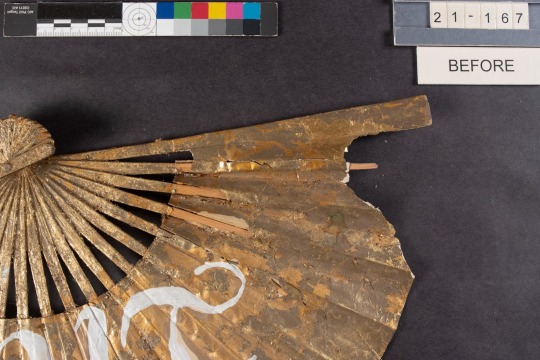
Figure 4. Details of the torn paper fan before treatment.
With the goal to stabilize the fan and improve its appearance, we decided to close the fractures, put down the lifted metal leaves, and reduce the surface dust and grime. I used wheat starch paste to adhere to the torn edges, and I used small strong magnets to press the joints together while the starch paste dried and cured. Adhering a small part each time, I worked along each fracture, and back and forth between the two sides to make sure things align correctly. There was one tear that went along a fold line of the fan. The two sides of the tear had little overlap for adhesion, like the two halves of a malfunctioned lifted bridge. I used a strip of Japanese paper coated with starch paste and a synthetic adhesive called methylcellulose to mend this tear––now I put an extra bridge over the broken one to hold the two sides together.
I introduced gelatin solution as an adhesive to reattach the leaves to the paper. And after the leaves were secured, I used dry pre-washed cosmetic sponges to clean the surface. I cut my sponges into tiny wedges so that I can maneuver a small piece between and over fragile metal leaves. After the treatment, the fan’s paper structure was more stable, and its surface recovered some of its past glitter (fig. 5 & 6).

Figure 5. Details of the torn area after treatment.

Figure 6. The “Gold Fan” after treatment.
Rehousing objects from the David Wojnarowicz Papers MSS.092
Organizing objects crowded in a box can give conservators headaches. When I opened “box 139”, I did not know how many objects were there. It was only after taking a documenting photograph, I realized that 28 objects were crammed into one archival box (fig. 7). They are made of various materials, including metal, plastic, fabric, stone, and glass. These random things were collected by American artist David Wojnarowicz (1954–1992). Some were used as props for his photographs. For example, I noticed that a clock face, “object 092.2.0492”, with Roman numbers might be featured in his 1988 photo Untitled (Time/Money) in the Ant Series (fig. 8).
My mission is to identify the plastic objects and separate them from the rest of the objects. Apart from visual observation, I used Fourier-transform infrared spectroscopy (FTIR) to analyze materials that are suspected to be plastic. This analysis can be used as a non-destructive method. The object’s material of interest could be clamped down against the analysis window on the stage to gain data (fig. 9). Yet not all objects could be fitted onto the stage. Because the machine was intended for industrial use, where samples are usually in powder (such as drugs), the space between the stage and the built-in clamp is limited. The analysis also requires that the surface of the object be pressed against the window on the stage. The pressure can also leave tiny impression marks on some objects due to the clamping. So while the analysis may be non-destructive, it might damage the object.
Though identifying plastics with FTIR was fun, the most interesting part for me was driving a polyester encapsulation system with an ultrasonic generator and motor control. The instrument allowed me to create 35 small Mylar pockets custom-made for the objects. “Object 092.2.0504” consists of small charms (34 metal pendants and 1 feather). Before rehousing, they were stuffed in a small bag made of bubble wrap and brown pressure-sensitive tapes. After rehousing, each charm was snuggly fitted in its pocket (fig. 10). A visitor can easily see both sides of the charms by handling the Mylar sleeves.
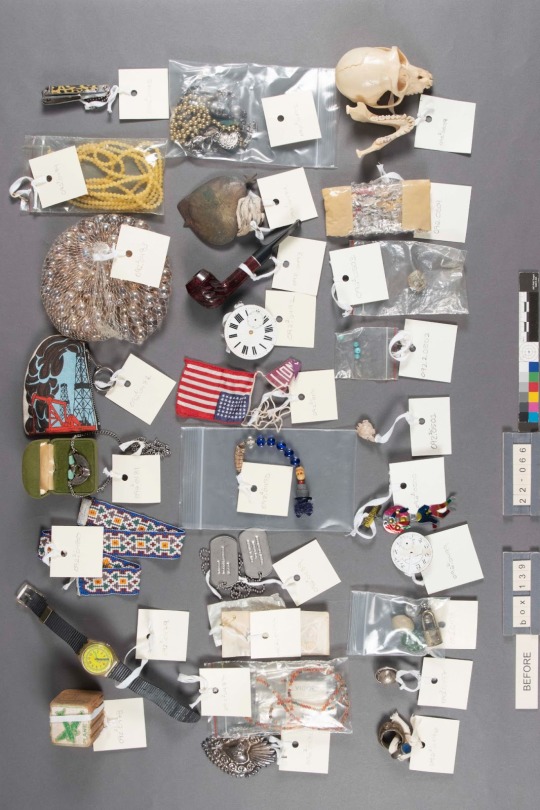
Figure 7. Objects from the David Wojnarowicz Papers.

Figure 8. David Wojnarowicz. 1988. Untitled (Time + Money). Photographs. Gelatin silver print on paper.

Figure 9. FTIR analysis of a scarecrow candy container manufactured by the E. Rosen Company at Rosbro Plastics in the 1950s. The cardboard was added to support bigger objects on the stage.

Figure 10. Charms rehoused in Mylar pockets.
Conservation of Balinese Shadow Puppets in the Mabou Mines Archive MSS 133.
I first knew about the project of the shadow puppets from my supervisor Jessica on September 23rd, 2022. I thought it would be another rehousing project. I did not know that I would study, research, and work on the puppets till the last day of my internship. The project included research, artist interviews, treatment, and rehousing.
The 40 shadow puppets (133.2.0023 through 133.2.0053) were mostly made for MahabharANTa, written by Lee Breuer and performed in 1992 in the United States. The story is a battle between the animals and insects on the White House lawn. The puppets are flat shapes attached to wooden and bamboo handles. 6 puppets were made of paper materials, and the rest were made of painted rawhide. Balinese shadow puppet master (dalang in Balinese) I Wayan Wija made all the rawhide puppets in Bali. The puppets have fragile paints that needed consolidation. They also needed rehousing because they were originally sandwiched in flimsy paper folders and piled in two boxes.
If you are interested to learn more about his project, a recording of my presentation on the project is available through this link. Here, I want to tell you some things that are not in the treatment reports or my presentation.
An episode before everything began was taking the documentation photos of the puppets, some of which measure 26 to 28 inches long, and some have multiple moveable arms, jaws, and even antennae. Photographing colorful objects could be hard for the background color must be right. I first opted for black, the default color of the background paper already set up in the photo room. I soon realized that many puppets have black parts and all of them have dark outlines, which happily blended in with the black background. Then I tried neutral grey, a color that conservators love. The issue was that a similar grey was used on the puppets. The grey areas can be mistaken for hollow places (fig. 11). Finally, I decided to use white as my background. There was no white background paper in the photo room. Fortunately, there are plenty of white things in a book and paper conservation lab. I used a large piece of Artcare foam core as my white background (fig. 12). I regretted that I did not try different colors against just one puppet at the beginning, but caused extra handling of all puppets. Bits of paint did come off when I moved puppets around. This was a lesson learned hard.

Figure 11. Before treatment photo of the “chariot” shadow puppet against neutral grey.
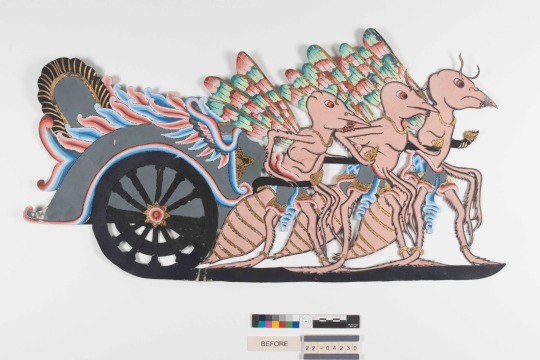
Figure 12. Before treatment photo of the “chariot” shadow puppet against white.
Though I started on the project in 2022, I did not treat the rawhide puppets until 2023. Jessica and I did research into the puppets because the finding aid provided inadequate information, missing the artist and date, and whether the paper and rawhide puppets were made for the same performance. So in 2022, I treated and rehoused the paper puppets while learning about Balinese shadow puppets. Jessica and I did archival research in the Mabou Mines archives, and we found that the puppets were all made for the same performance. Two names came up as the designers of the puppets, Larry Reed and I Wayan Wija. We contact Larry Reed who told us that I Wayan Wija made all the puppets. Pak Wija lives in Bali. Our first few emails ended with no responses. When we were thinking that we would never find him, I found, on the website of the Smithsonian National Museum of Asian Art, an article on Balinese shadow puppet theater by Professor Lisa Gold. She met with Pak Wija and featured him in her article. I emailed her and she provided me with Pak Wija’s contact information. In February, Jessica and I interviewed Pak Wija on Whatsapp.
While the research slowed down the progress, we were grateful that we did not skip it. We learned that the Balinese puppets have sacred entities beyond their physical materials. Balinese puppets were alive in performances, needed to be fed and paid respect, and have the healing power to help people in return.
As conservators, we had limited power beyond taking care of the physical materials; Not a Balinese shadow master, or dalang, I could not take care of the spiritual parts of these puppets that I could not see or touch. According to Balinese traditions, untrained hands were not even allowed to handle sacred puppets. But Jessica and I were proud of our work. I think what we tried to do was to restore the connection between objects and people, giving back the puppets their identities and meanings. I think getting to know them is a starting point for paying the puppets the respect that is overdue so that others can do better in the future. The bond between the puppets and the people would have been lost in time and the dark storage rooms if we did not bring the puppets to Conservation.
The greatest challenge was the consolidation. To stabilize the paints, I fed an isinglass solution into detached paints to stick them back down and to hold tiny flaked paint pieces together. I chose to treat the “chariot” puppet as a trial. It took me a month to finish it. At that time, I had less than 5 months left and 29 puppets to treat and rehouse. Plus, the old stock of isinglass was running out, and I had to extract a new batch to carry on.
So finally I told Jessica, “I don’t think I can treat all the puppets.”
But the puppets might not have the chance to be treated again with enough space, time, and budget. Jessica and my colleagues said I should give it a try. The whole book and paper lab helped in making the new batch of isinglass. Jessica and I agreed that I would treat the most unstable ones as our priority. So that even if I could not treat every single puppet, the ones left would be relatively stable.
I used a Leica microscope to guide the consolidation. Examining the parts that need treatment under powerful magnification allows me to grasp the microstructures of unstable paints and find out a strategy for approaching each situation. Some look like colorful tents, volcanoes, cliffs, and archipelagoes. I found myself diminishing in size, taking a walk in these landscapes. Strangely, with the pressing deadlines, I did not feel like a desperate traveler in a hurry to get to a destination, but more like an explorer on a joyful journey.
When the final month approached, Jessica and I decided to rehouse all puppets and finish their reports before I carry out more treatment. I cut archival blue boards and cut them into the sizes of the boxes. And I attached soft Volara foam blocks as bumpers to hold the puppets in place. And Ethafoam blocks were added to the board so trays could be stacked in a box without pressing on the puppets.
Before we wrap up, Jessica and I met with Weatherly Stephan (Head of Archival Collections management) and Nicholas Martin (Curator for the Arts and Humanities) to share my research findings so that information regarding the maker, date, and correct names of the puppets can be incorporated into the finding aid. For the housing information to be updated and to facilitate clarifying “what went where”, I created a Google document with an illustrated rehousing scheme for reference. Jessica will also keep the research information, including the artists’ contacts, for future reference.
I ended with all the puppets rehoused with their own reports. Of the 37 treated puppets, 30 were consolidated. There are 3 puppets left to treat, but the amount of work required should be minimum.
Ending
I am grateful for working with so many kind and professional people during the past months. I want to give my special thanks to my supervisor Jessica Pace. Jessica helped me better understand the priorities of different tasks. This project is in debt to her patient guidance, communication, and foresight. You can also find out more about the people at NYU Libraries through the staff directory.
I want to thank any patient Tumblr reader who read thus far. If you are eager for getting into Conservation, please find out more at the Emerging Conservation Professionals Network. You are also welcome to contact me via email [email protected]. I am happy to talk about my experience and projects, or just discuss random nerdy things in Conservation.
14 notes
·
View notes
Text
Auto Glass Repair Tips for Hail Storm Damaged Windshields
Hail storms can wreak havoc on vehicles, especially windshields, leaving behind a trail of cracks, chips, and shattered glass. Dealing with hail storm damage can be overwhelming, but prompt action and proper auto glass repair techniques can help restore your windshield's integrity. In this blog, we will provide essential tips for repairing hail storm damaged windshields, helping you navigate the process and ensure your vehicle's safety.

1. Assess the Damage: Before proceeding with any repairs, carefully assess the extent of the damage to your windshield. Small chips or cracks may be repairable, while larger or more severe damage may require windshield replacement. Contact a professional auto glass repair technician to evaluate the damage and recommend the appropriate course of action.
2. Protect Your Vehicle: If you are unable to repair the windshield immediately, take steps to protect your vehicle from further damage. Cover your car with a tarp or park it in a covered area to prevent additional exposure to the elements. This will help prevent water seepage, which can worsen the existing damage and lead to further complications.
3. Temporarily Prevent Further Damage: To prevent chips and cracks from spreading before you can repair them, apply clear nail polish or a temporary windshield repair kit. These products act as a temporary sealant, preventing moisture and debris from penetrating the damaged area. While this is not a permanent solution, it can help stabilize the damage until you can get professional repairs.
4. Avoid DIY Repairs: Although there are DIY repair kits available on the market, it is generally recommended to leave windshield repairs to the professionals. Windshield repair requires specialized tools, materials, and expertise to ensure a proper and safe repair. Attempting to repair the windshield yourself may lead to ineffective repairs, further damage, or compromised structural integrity.
5. Seek Professional Auto Glass Repair: Consult a reputable auto glass repair company that specializes in hail storm damage repairs. These professionals have the experience, knowledge, and equipment to assess and repair the damage accurately. They may employ techniques such as resin injection or windshield replacement, depending on the severity and location of the damage.
6. Insurance Coverage: Check your insurance policy to determine if hail storm damage repairs are covered. Many comprehensive auto insurance policies include coverage for windshield repairs or replacements. Contact your insurance provider to understand the claims process and any specific requirements for filing a hail storm damage claim.
7. Timely Repairs: Address hail storm damage to your windshield as soon as possible. Even minor chips and cracks can worsen over time due to temperature fluctuations, road vibrations, and stress on the glass. Prompt repairs can prevent further damage and potentially save you from needing a full windshield replacement.
Dealing with hail storm damaged windshields requires swift action and professional expertise. Assess the damage, protect your vehicle, and seek the assistance of a reputable auto glass repair company. Avoid DIY repairs and consult your insurance provider to understand coverage options. By taking these steps, you can effectively address hail storm damage and restore the integrity of your windshield, ensuring the safety of you and your vehicle on the road. Remember, timely repairs are key to preventing further damage and maintaining the longevity of your windshield.
Advantage Auto Glass Toronto provides excellent windshield repair service in Toronto.
To get our services, visit https://www.advantageautoglassrepair.com/
16 notes
·
View notes
Text
The Mighty Nein's MtG Decks
Because apparently my current niche is oddly specific headcanons and also @fluffmonger asked. These are all gonna be commander decks because that's what I play. @qumulox helped too.
Fjord- Galea, Kindler of Hope. Equipment tribal to the max, with all kinds of Hexproof this and Protection from [COLOR] that. He has strong feelings on deck composition and ratios, and he's very meticulous about it. He keeps everything in Dragon Shield sleeves and Boulder boxes color coordinated with the deck's colors, and he's had the one same UltraPro playmat for years and doesn't see why people change them.
Beau- Yuriko, the Tiger's Shadow. Just to be rude as hell. You'd think she'd have a monk deck, but they're too slow and don't pack enough oomph. Beau will claim she just tossed it together, but in reality she spent hours on EDHRec and Reddit pulling together an optimized list. She's got one of the schmancy premuim leather mats that's cobalt blue, but she balances out the bougie by using $3 UltraPro sleeves.
Caleb- Yes. That isn't a card name, Caleb is just 100% your deck brewing buddy who never keeps a deck longer than two meetups and is constantly noodling with something new. Sometimes it's aggressively potent. Sometimes it's trash. Sometimes he makes a Group Huh?? deck just for shits and giggles. But you can always count on him playing on a pristine cat themed playmat, and his Satin Towers are somehow always immediately damaged.
Veth- Grenzo, Dungeon Warden. Full aggressive red/black that is just mean (and she thinks it's funny to use the Goblin Rogue). Flood the board with dudes, and as many sacrifice spells as needed. She throws Treasure mechanics in there for funsies and uses buttons as the tokens. She doesn't sleeve her deck or use a playmat, if only to watch Caleb wince as she riffle shuffles.
Jester- Toski, Bearer of Secrets. Jester has a squirrels deck because of course she does. She also makes decks based on the art, and they're much better than they have any right to be. The sleeves? Custom printed with Traveler art. The playmat? She did her own rendition of the cover of Tusk Love and got that custom printed too. Jester also paints custom card alters.
Molly- Nymris, Oona's Trickster. His whole theme is just stacking his deck and doing card tricks with anything that has Flash. The whole deck is either foil, Secret Lairs, and/or whatever he finds the prettiest, but also he keeps the whole thing in Pokémon sleeves he traded a kid for and he plays on a Vanguard mat that got left behind at a shop. The deck is in a sandwich bag and he never bothered to get a tube for the mat. Side note, Molly is 100% the type of person who has a very nicely proxied Black Lotus in a penny sleeve with a staple through it just to fuck with people.
Caduceus- The Gitrog Monster. This firbolg can play so much Golgari. It's all life, death, the land, pulling things from the graveyard, building from what you sacrifice. Caduceus keeps his cards neatly in nice mint Dragon Shields and a pretty wood and resin box he found on Etsy. He plays on a cloth playmat he found there too.
Kingsley- Zacama, Primal Calamity. Kingsley made a dinosaur deck in Ixalan and was set for life. He also threw a treasure subtheme into his just for giggles. Kingsley picked some anime sleeves for something he'd never heard of before because he thought it was hilarious, and his playmat was swiped from a freebie bag of Playmats Long Lost at a game shop. A habit that goes across souls? Keeping decks in a sandwich bag.
Yasha- Oloro, Ageless Aescetic. It's just a numbers game. Yasha really only plays because her friends do, so she just gains life until she gets bored and starts slamming people with Aetherflux Reservoir. She's got a beautiful mat that is a print of Jester’s flower mural, and she's got awesome lighting bolt sleeves.
Essek- Sen Triplets This man is not here to fuck around. It's just hard control all the way down. He's got a Grand Arbiter Augustin IV in there "because it's synergistic." Listen man. Essek Thelyss is that rude bitch who rolls up with a leather gaming bag, a vermaloc purple heart deck box and a purple leather playmat and custom sleeves and has the nerve to turn his nose up at your UltraPro mat.
31 notes
·
View notes
Text
A Creative Witchy Blog Post Title
Hello, my friends! today i will be revealing some different methods of worship when i pray to my wonderful, and most dear friend, Aphrodite!

What do i do, you ask?
I have a small altar set up for her, in my quarters, where i do most of my practice.

Where’s the image/vision of her? I haven’t found the right image/vision to represent her yet. It’s still a work in progress, and yet, i know she’s happy.
First, i have a lot of silver, for i believe that she likes it.
Second, i have spoons, an athame, and a fork on her cloth, which i use to have meals with her. i do that often, for i don’t like eating in front of people and this is my substitute for such.
Third i have brushes for anointing my equipment with oils and resins.
Fourth, i have a deck of cards that i use to communicate with her on occasion (i mostly just pray).
Fifth, i have a crystal cluster that reminds me of her, and when i go out, i carry it with me to remind me to take care of myself and love others.
Sixth, and finally, i have a strip of leather that says “may she guide” in Theban, the language of Witches. I intended to make this into a bracelet, but didn’t have the materials necessary.
And yes, i made the altar cloth :)
With my daily routine, i often whisper prayers to her, for i love how she can guide me in the little ways. I do my beauty routine every morning right by my altar for her, so that i am reminded of the divine beauty that guides me.
When i am desperate, or in need of comfort, i often grovel on a mat, that i repurposed from a rug, and cry out to her.
You do not need to follow how or what i follow. Everyone does something different, and i have not found one person who practices their (any) religion the same way.
I pray that she guides and protects.
Blessed be, my friends and witchlings
-waaxfeathers
#aphrodite#witch#witchblr#witch community#hellenic polytheism#aphrodite worship#altar setup#worship#pagan witch
3 notes
·
View notes
Text
Resin printing CAN be cheap, as cheap as using DAS clay for prototyping instead of Ladoll or Epoxi clay. However, a good printer (+499$) good, durable resin not brittle shit stuff (+60$ per liter) curing station (+80 DIY/300$from company) plus protective equipment (+120-400$) plus sandpaper, and other consumables for finishing the print (30/60$)... they all add up. That's not even considering the cost of Primer and filler clay for prototypes. People think I'm making money out of this. Yes I do, but cost of the doll barely covers the prototypes/ finishing/casting/shipping materials/ taxes.... I make like 20$ per doll and that doesn't even cover the hundreds of hours invested in working. I really help and welcome everyone into the hobby, but dollmaking is not for the money greed..... It's my job and I barely make it for food through winter...
~Anonymous
16 notes
·
View notes
Text
There isn’t a perfect crafting material and one isn’t strictly “better” than the other: a blog post styled rant on why people need to stop asking which material is the best and why 3D printing pieces for cosplay is not ‘cheating’ or easier than any other method
I have seen waaaaay too many people lately (especially on the clock app) claiming that 3D printing is cheating or somehow easier than the low tech, older methods like foam work and thermoplastic crafting. This absolutely drives me crazy.
I am a fabrication girlie at heart. I am a foam gremlin to the core but started out with Worbla (a delightful classic). I have recently picked up sculpting/mold making/resin casting. I am teaching myself how to 3D model. I have put hundreds of hours into finishing the dozens of 3D printed props and bits & baubles I have for various cosplays. I have worked with air drying clays, apoxie sculpt, paper mache, and chainmail. I work both in the digital and physical spaces for patterning. I have won several major craftsmanship awards with my fabrication skills. With all that as my credentials, let me say that 3D printing is not any easier, faster, or somehow better than all the other things I mentioned.
There is no such thing as a perfect crafting material. Anyone that tells you that is trying to sell you something. Every material and it’s corresponding techniques have pro and cons- the things that it excels at the and the things that it doesn’t work so well for. Wether it is a high-tech and automated process or a low-tech process done mostly by hand, every material can be utilized poorly or expertly. What makes the difference in the quality of the finished product or what wins awards in craftsmanship contests is how the material/technique was executed. A low budget cosplay can beat one that used tools that cost upwards of $1,000. It’s all about HOW the materials and tools were used.
For every 3D printed piece, there are lots of steps. You don’t just press a button and magically have a beautifully finished sword or geometric little Genshin Impact accessory piece. No, not all.
It has to be modeled first, then run through a slicer program to be printed. There’s lot of behind the scenes calibration that has to be done on the printer and adjustments of the model to get it in the optimal position to minimize seams and support material. There’s adjusting settings on the printer, like infill, to balance strength of the finished print vs amount of filament used (and therefore the final weight of the print). After printing, you have to remove support material and clean up the raw print. Next up is the eternal limbo of filling and sanding (god, it takes forever). Depending on your seams, you may be stuck in Bondo hell for a while too. Finally there’s painting, which can range from a quick blast of spray paint but could turn into the exceedingly complicated process I like to do that ends up using about six different paints. Then there’s the clear coat to protect the finished product.
A 3D printed prop does not magically appear from the ether. Much like any other material, there is a long list of steps and so much work put into a single piece. By the nature of how 3D printing works, pieces will come out very exact and crisp with a precision that human hands can’t quite achieve. But that comes at the price of expensive equipment, a steep learning curve for 3D modeling, and countless hours invested into the entire process from beginning to end. Even with purchasing models as I often do, it’s still not easy, cheap, or fast to make 3D printed pieces for cosplay.
Foam can win over 3D printing and sewing can beat out any fabrication build. It’s not a matter of WHAT was used. It’s a matter of HOW WELL it was used. Craftsmanship is not determined necessarily by the material but by the skill of the person using it. 3D printing is just a different set of skills than what is needed for Worbla or EVA foam.
2 notes
·
View notes
Text
in the delaware river area today,
"Trinseo PLC, which owns the facility where the spill occurred, said in a statement on its website Sunday it “appears to be the result of equipment failure.”
The latex product chemical spill happened on Friday evening at a facility in Bristol, Pennsylvania, which manufactures acrylic resins, according to the statement.
The company estimated 8,100 gallons of solution – which is half water and half latex polymer – was spilled.
“The latex emulsion is a white liquid that is used in various consumer goods. Its pigmentation makes the water-soluble material visible in surface water,” the statement reads.
The Pennsylvania Department of Environmental Protection said an “unknown amount” of the spilled product had entered the Delaware River. Water sampling is ongoing and contaminants have not been detected at drinking water intakes, the department said in a Sunday statement.
Fish and wildlife are said to have not been affected, according to the statement."
initial reports say that its not impacting water, but water has been stocked up and warnings for rationing your water usage is in place.
3 notes
·
View notes
Text
Great thing about free time is you never really know what you’re going to end up doing, learning or seeing. One day last week when temperatures were not in the 30s, we left on foot toward South Perth (known for the Perth Zoo but not our chosen destination) with only exploring in mind. We reached the bottom of Kaarta koomba (Kings Park) bluff and had a busy freeway to navigate across. I saw a pedestrian overpass in one direction but Craig noted an unmarked cross walk the other. In Australia, you may already know but vehicles have the right away so crossing a freeway can be a very harrowing experience. So a sandy gritty walk to the overpass it was.
The overpass itself was noticeably immaculate, air conditioned and linked a three level parking lot (or car park) to The Old Swan Brewery - a beautifully restored red brick building on the riverfront visible from downtown (or CBD central business district) Perth. The old brewery ceased production in 1966 and is now condos, offices, a restaurant (Cooee) and a non-operational brew pub (why it is not open is beyond me - imagine a brick RVYC building in Stanley Park, Vancouver with a fully built out antique bar and you can walk along the seawall to get there).
Cooee’s patio looked out to the Swan River and seemed so zen we decided to stop for an iced dirty chai latte and banana bread (wondering where did the banana bread craze come from?). We voted this chai the best we’ve had ever.
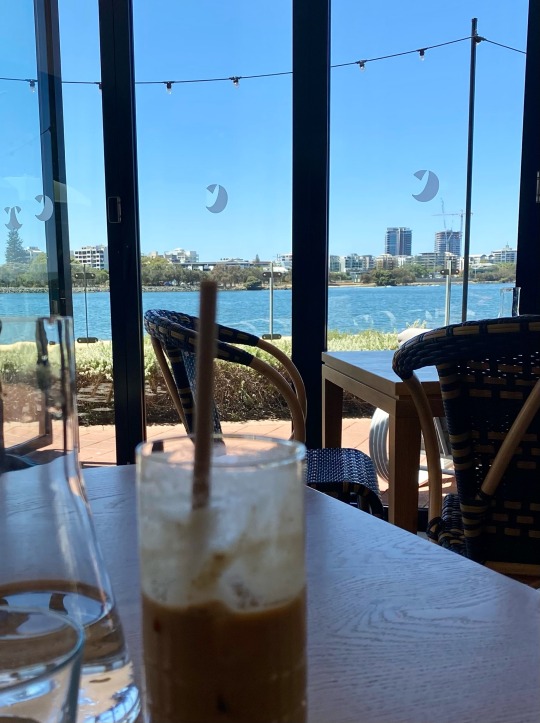
Recharged and emptied bladders, we set off across the bridge. The salt water river was jammed with huge ominous jellyfish which made me wonder about efforts to rejuvenate the ecological health of the Swan River. Couldn’t find much online but hopefully someone’s concerned about it and taking action. Update - apparently the rise in water temperature is responsible for the increase in jellyfish. This guy is kinda gross and harmless but apparently very protective of the lighter coloured ones that do sting.

The waterfront park and walk on the south side was expansive and quiet. The condos along South Perth Esplanade (such inventive names) were a nice mix of decades of design and the grounds all well manicured. There’s a catamaran ferry (small seabus) that runs every fifteen minutes to the CBD for $2.30 each way. Once you reach the dock of the ferry, you’ve reached the hub of South Perth - felt a little bit like Edgemont. We wandered up through the Shopping Plaza (basically a lobby area) and onto the street and headed towards the park and the zoo, stopping a a quaint little museum. Apparently South Perth was joined to the rest of the city by the tram system back in the early 1900s, much to the dismay of some of its residents. In fact one person shot at the conductor and the tram when the situation reach its boiling point. And we saw the sketches of May Gibbs, former Perth resident who is famous for her gumnut babies tales and illustrations. Further on our walk, the zoo didn’t appeal enough to pay the entrance fee but we did learn of the hardy grass trees (balga) a staple of the aboriginals, which flower after bushfires and their sap mixed with charcoal and kangaroo poo makes a superglue resin (some dirty hands must have discovered that!). As well as the grass trees and the related information sign, I wanted to show the solar panels used as a covered shaded walkway up to the zoo entrance. How clever.

Wandering back through the shopping area, including some frivolous clothing try ons, we took note for future visits that some of the condos have monthly rental available. We discovered the Good Grocer (Urban Fare like) with all its healthy reasonable readymade food options. While we continued our walk along the seawall, it was reaching the high for the day of 29. Up ahead a sandwich board sign caught my eye about a driverless vehicle test being conducted by RAC (Royal Automobile Club like BCAA or AMA) so we signed up for it in the hopes of escaping the heat.
The 11 seater electrical bus (equipped with ceiling straps for more standing passengers) has been gathering data since 2016 (7 years!) on a programmed route between the riverfront and The Old 1835 Mill (more on that later maybe). This route is about 2km and 1/2 hour return trip apparently using superior technology to Tesla. There were three buses manufactured but only one currently in daily operation except during lightning storms. I’m wondering why there’s not more of these on the roads gathering data and why there’s not enough data gathered after 7 years to show the ideal options for the safe use of this technology. Hospitals, public park maintenance, airports all seem reasonable places to use these autonomous vehicles to transport people safely. Apparently legislation is blocking further expanded use of them. Wondering how reactionary human operators could be viewed as safer than these emotionless and egoless programmed electric vehicles operated at optimally efficient speed.

Our surprise day ended with a riverfront dirty martini happy hour and quinoa salmon salad for dinner and a driver operated ferry and bus ride for our return trip back. Who knew what this 15k step day would bring.
#old swan brewery#cooee#jellyfish#improved#swan river#best chai#electric vehicles#driverless#south perth#grass trees
3 notes
·
View notes